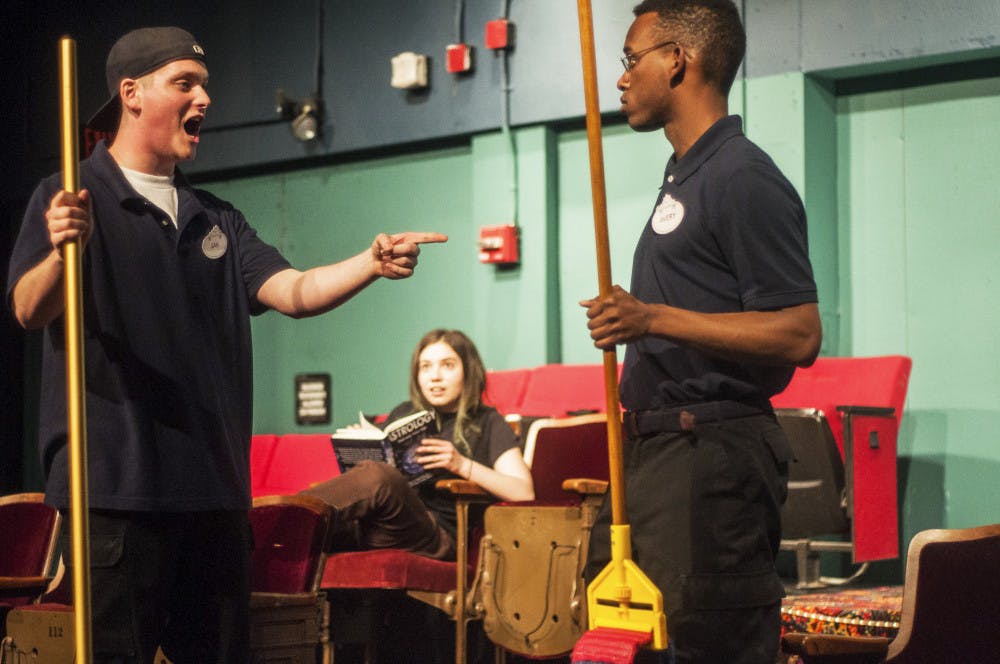I still remember my most unusual — and potentially most embarrassing — Halloween costume. I was 10 or 11, and my movie-obsessed friends thought there would be nothing more clever than to glue a large slab of black cardboard to our shirts, stick half-eaten popcorn and spilled-drink containers to the paper, and call ourselves a movie theater floor. It was likely the first time I thought about all of the trash left behind when the credits roll.
Ten years later, Annie Baker’s play “The Flick” brought me back to this world, this time exploring less the trash and more the people who clean it up. Baker’s slow-burning play is intentionally lacking in theatrics, instead acting more as an exercise in testing the audience’s patience, with whole scenes consisting of characters performing mundane cleaning tasks. Reading the play shortly after it won the Pulitzer Prize for Drama in 2014, I knew that Baker’s message was profound, yet the scripted pauses and mammoth runtime of three hours tested audiences who attended the original Off-Broadway production — those who stayed past the first act, anyway.
But director Sam Rubinek’s ’17 superb production of “The Flick,” which concluded its run Monday at the Production Workshop, did not encounter these pitfalls, precisely because Rubinek was aware of them. He noted that while most shows are “dialogue punctuated by silences,” Baker’s writing is more “silence pierced by dialogue.”
To call this production silent by any means would be a disservice to the small noises — the sweep of a broom, the crunch of a popcorn kernel, the whirring of a projector — that make up life at the theater. Boosted confidently by Josh Cape’s ’17 set design, featuring mismatched chairs and an appropriately hideous carpet that evokes Hollywood B-films, and Ahmed Ashour’s ’19 straightforward lighting design, the production successfully conjures the monotony of everyday life for the workers.
The show opens on Sam — the oldest and most seasoned of the three workers, portrayed with nuance by Peter Bowden ’16 — teaching tight-laced newcomer Avery, played by Brad Weekes ’17, the ropes at Worcester County’s last remaining movie theater with a film projector.
The first third of the play, which watches Avery and Sam’s friendship develop in real time, is often intentionally uncomfortable; Avery’s youth and almost robotic social nature could not be more different from the casual and more reflective Sam. But Sam and Avery are not alone at the theater — the spunky and hilarious Rose, portrayed by Emma Miller ’16, maintains a mysterious presence for the majority of the first act, seen only through a window into the projection booth looming over the theater.
The show, portrayed as a series of vignettes in the lives of these three characters, is at its best when all three are on stage, but the superb performances of Miller and Bowden often overshadow Weekes, whose less natural performance, while understandable given Avery’s character, comes across as less authentic than that of his co-stars.
But the staging and Baker’s writing are such that we are drawn to Avery as the show’s emotional center; his desire to work at a theater with a film projector comes from his yearning for truth and authenticity. For him, watching a movie not projected on film is like “looking at a postcard of the Mona Lisa” instead of the painting itself.
Avery’s discussions with Sam about what makes a great film — and, by extension, great art — reveal a level of insecurity regarding reputation and a desire for validation, ultimately sparking questions about broader themes of identity. Avery fears that his future will not take the right path and hopes that he can look back and know he “made the right choices,” while Sam reflects on the choices he has already made and the path that led him there.
The characters question what it means to be oneself and how one can be authentic when it feels as though the path is no longer clear. Baker asks us to reflect on whether our expectations for ourselves are too high, whether we seek too much and whether it is still okay to “settle,” however we choose to define that word. We watch as Avery, Sam and Rose learn to trust one another — and then, in a particularly devastating scene, to lose that trust — as they argue over topics including race, ability, sexuality and class, viewing in close-up the subtleties and nuances that connect us to other people. Such an emphasis on face-to-face communication is ironic given the play’s focus on the shift to digital cinematography.
This show is not for everyone. It is long, uncomfortable and polarizing. A college-aged audience would relate most deeply with the stories of coming of age and finding oneself that the production explores, but young people, accustomed to faster-paced Friday night recreation, may be the ones most unsatisfied with the slow speed of the performance.
In many ways, the pacing of the show is slower than that of real life, perhaps so that we are able to fully process and appreciate each moment as opposed to immediately casting it aside, as we so often do in a digital world. But the show is more true to itself, and to life, than most I’ve seen, celebrating the smallest of moments and deftly tackling deep questions like the youthful quest for authenticity.
Indeed, Avery does look for authenticity throughout the show, and he finds it in this movie theater, looking at a non-existent screen that should rest where the audience sits. It seems that we almost make eye contact with Avery, wanting to close the gap between the audience and the stage. But we remember that Avery is still a character on a stage, there to remind us of the beauty of the reality we leave behind in entering the world of theater.





